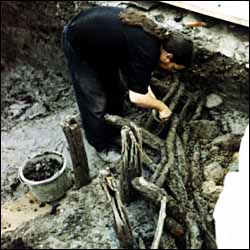| The
friars revetted the banks of the stream bordering their plot of
land, first with wattle fences, later with stone walls founded on
wooden piles. This was apparently to guard against occasional
floods. These pictures give an impression of the time consuming and
patient work involved in exposing the wooden remains, so that the
timbers could be conserved and dated by the tree-ring method
(Dendrochronology). |

|

Cleaning a wattle fence.
|

Revealing the tanners' workshop.
|

|

Tanner. Woodcut from the "Ständebuch"
of Jost Ammann (1568) |
After
the dissolution of the friary during the Reformation, tanners set up
a workshop along the friary stretch of stream, which was by this
time reduced to a trickle. They canalized the remaining water into
wooden troughs which fed wooden tubs and wicker-lined pits, in which
the chemical tanning processes were carried out. Huge amounts of
cattle skulls, which were delivered with the hides for tanning (as
can be seen in the old woodcut), were found next to these features.
The tannery workshop had to be given up towards the end of the 17th
century as the stream dried up completely. |

|
| The
remains of this and perhaps other suburban industries doubtless
continued to the south of the stream, but could not be investigated
properly due to lack of time. Thus important information regarding
the social environment of the friary has been lost. Such is the fate
of the urban rescue archaeologist! |